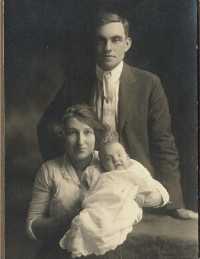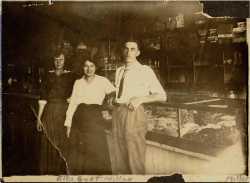Sign up for the Family Tree Newsletter Plus, you’ll receive our 10 Essential Genealogy Research Forms PDF as a special thank you!
Get Your Free Genealogy Forms
"*" indicates required fields
 |
 |
| Figure 1 | Figure 2 |
Which is worse? Having an unidentified photograph, or owning an identified image and not knowing anything about the person in the picture? For Michelle Hawkins-Woodard, it is the latter.
Her family owns two pictures. Figure 1 is a family photograph of Ella Emma Gust, Jack Robert Miller and their son Curtis. Figure 2 is a photograph of the couple in the Gust family store in Windom or Jeffers, Minn. These two images are just the beginning of a family quest for a connection. Jack Robert Miller disappeared shortly after these photographs were taken. No one seems to know what happened to him. Ella moved to California, remarried and her son legally changed his name to his stepfather’s. Michelle is hoping that someone will recognize her great-grandfather and solve this mystery.
When you have an identified photograph like Michelle’s, there are several things you can do to locate information. The first step is to start with what you know. In this case, she has names and a date for at least one of the photographs: the family portrait. Jack Robert Miller and Ella Gust’s son was born in 1917. Michelle tracked down a birth certificate for their son in Minnesota. Actually, she has two copies. One is in English and the other in German where “Jack” is “Jacob.” The significance of these two certificates has not yet been determined. Since their son is the baby in figure 1, it dates from 1917.
Genealogists are taught to move backward in time, but since the goal is to explore Jack Miller’s life and not his ancestors’, it is helpful to go forward. Try to piece together what happened along the way. The family doesn’t know when Jack disappeared, just that he wasn’t around when the name change occurred in 1923. For example, when did Ella Gust and her son move to California? Try to create a timeline with historical events in place. Each event gives you somewhere else to look for documents and a to-do list.
Example:
1917: Son born
1918: World War I begins and the Influenza Epidemic strikes (Did Jack enlist or die from the flu?)
1920: US Census (Try searching indexes for Jack, Ella and son for Minnesota, California and places in between)
1923: Formal name change occurs in Minnesota
There are plenty of other records to consult, such as World War I draft registrations, city directories and court documents. Your family photograph will determine the types of records to search. For anyone trying to re-create an ancestor’s life in the 20th century, I recommend consulting Kathleen W. Hinckley’s Locating Lost Family Members & Friends (Betterway Books, $18.99). As you search, make a list of other family members you find such as cousins. You’ll want to contact each person to see if someone in that family holds the answer. News travels fast in families and distant relatives may know more than Michelle about Jack Miller’s absence.
Take advantage of online opportunities to make connections. Posting your images on a photo reunion site can help (see “Reunite with Family Photographs”). Some of the sites allow you to post known pictures to reunite with long-lost family. Since you want to follow as many leads as possible, don’t forget to post queries on online message boards.
Michelle is still trying to piece together the story of Jack Miller’s life. She has made some progress, but if anyone sees this picture and knows more about Michelle’s family, please e-mail me at mtaylor@taylorandstrong.com. I’ll pass along your message.
Find out how to submit your own picture for possible analysis by Maureen Taylor. E-mail her at mtaylor@taylorandstrong.com.
ADVERTISEMENT

